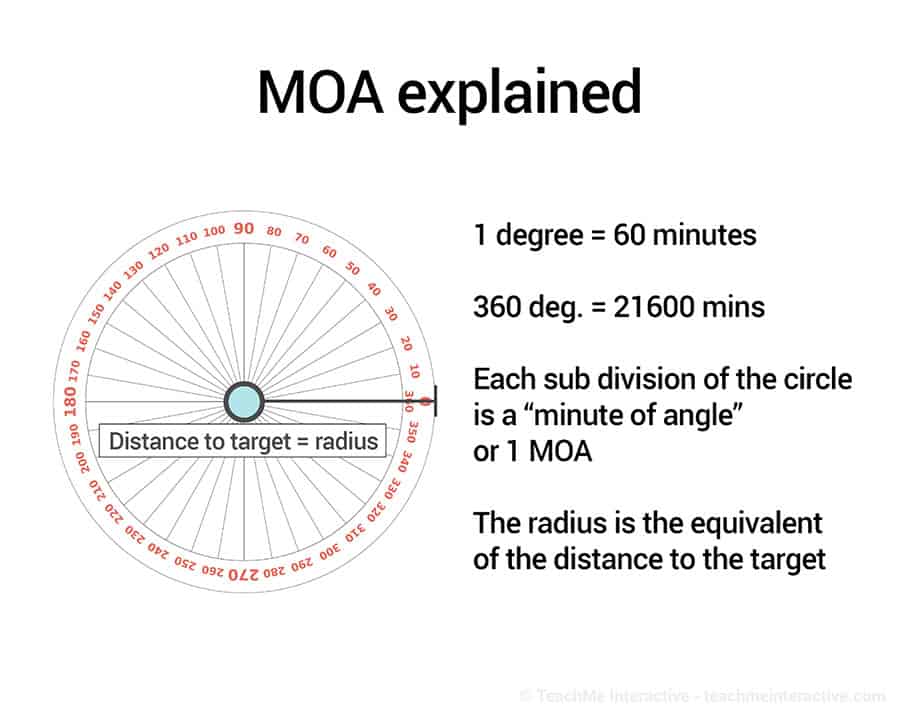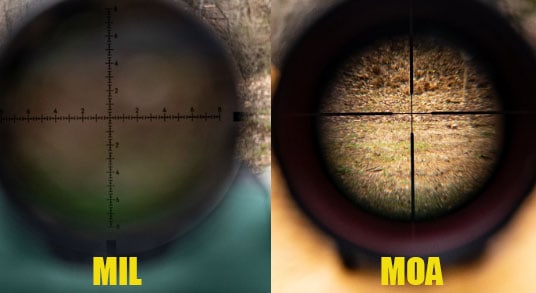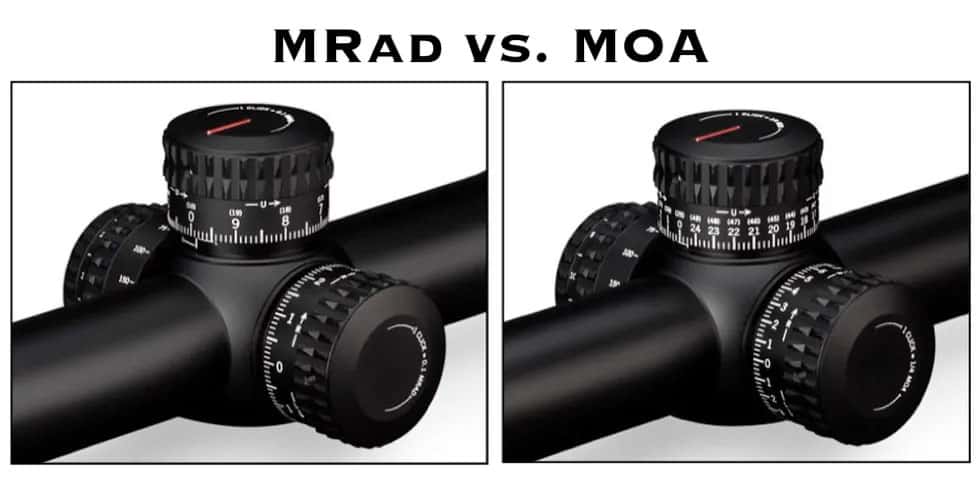
Congrats! You just bought your first rifle (or maybe your fifth), now it’s time to arm it with a powerful optic. But, that’s where you’ve found the problems. You walk into the shop and are bombarded with tons of questions that you have no idea what they mean. All of the scopes have some cryptic looking numbered labels. What do you do?
Well, today we’re going to discuss one of the biggest (and probably most confusing) debates in the firearm community of all time: MIL vs. MOA. Now, especially if you are a new shooter, these terms are probably overwhelming since they are so unfamiliar. Today, we’re going to break down what MIL and MOA mean, how you use them, what their differences are, and which one will suit you best when it comes to your rifle scope. So don’t stress, just read on. We got you.
Both MIL and MOA are just units of angular measurement that are used to zero rifle scopes. When it comes to a rifle scope, adjusting yours to meet your target depending on distance and other variables like wind or bullet drop is important for accuracy in a shot. Both MIL and MOA are equally as effective for sighting a weapon, it’s mostly just a matter of personal preference when it comes to which one you want to use.
Questions to Ask Yourself
Before we break down the differences between the two, there’s some questions you can ask yourself that might help to narrow down your decision just a little bit. These will help you understand your intentions as well as what style of shooting you are going to need for your purposes:
- Are you hunting small game, big game, varmints, or other game?
- Are you shooting short range, long range, or extreme long range?
- What type of firearm are you shooting?
- Are you already familiar with MIL or MOA?
- When using your rangefinder, is it in yards or meters?
- Do you normally use yards or meters?
- Are you using your scope for distance measuring?
- Are you using your scope for hunting or tactical applications?
While these questions aren’t going to give you an exact answer, they will help to guide you in the right direction as we start discussing the differences between the two systems. Keep your answers in mind as we go; you might start to develop a liking for one or the other if you remember them.
What is MIL?

MIL, as we said before, is a unit of angular measurement. MILs, also known as milliradians, is a measurement of a part of a circle. The details of how these measurement work are way beyond our discussion today, but just know that it involves the use of trigonometry. Basically, we use milliradians to estimate where our bullet is going to land on the target.
When you are using a mil dot scope, you will usually see crosshairs that extend with either hash marks or dots on the lines out from the center. A lot of times, a mil reticle is also called an MRAD scope, so don’t let those two confuse you. Today though, we’ll just use the mil scope name.
These hash marks on a mil scope turret will account for 1/10 of a mil. So, what exactly does that mean?
Well, the turret adjustments are what you use to zero your rifle. This means that you are adjusting your scope to account for where your bullet is going to land on the target as well as be able to account for things that might affect that shot, like bullet drop or wind.
Let’s take this into an example. One of the most common shooting/zeroing distances for a rifle is 100 yards. When you look through your mil scope at 100 yards, the aiming point should be in the center of the target. Any hash mark that is one above, below, left, or right of your target is going to equate to 3.6 inches of distance on your target. What this means is that every adjustment you make moves your aim point up or down 3.6 inches.
Say you hit your target at the first dot that is below the center of your mil reticle. This means that your shot landed 3.6 inches below the center of your target. Therefore, you would adjust your elevation turret about 10 clicks up in order to compensate for that bullet drop. If you’re wondering why 10 clicks, just remember that 1 turret adjustment is equal to 0.10 mils. It takes some math to learn, and might be confusing at first, but it’s easy to use and understand once you’re out in the field using a mil dot reticle.
What is MOA?

MOA is just another form of angular measurement. MOA stands for minute of angle, and deals with the amount of degrees in a circle. This is similar to milliradians, but mils are later than MOA angles. MOA is known to be a little easier to understand though. One degree in a circle is equal to 60 minutes, or MOAs.
When using a MOA scope, you’ll probably see some sort of crosshairs or reticle that has hash marks that extend top, bottom, left, and right. It will look very similar to the MIL scope, just with a different unit of measurement. A MOA optic is used to predict where your bullet is going to land on your target, as well as being able to compensate for things like bullet drop and other variables that might affect your shot. Each of those dashes will be 1.047 inches apart on your target for a true MOA scope, which is significantly smaller than the MIL scope. Sounds familiar, doesn’t it?
Each turret adjustment on a MOA optic typically equates to 1/4 of a MOA. Also, since the value of a MOA scope reticle is nearly just 1 inch whole, a lot of scope systems will round the reticles to an inch for simplicity.
Let’s use the same example as before. You are sighting your firearm for 100 yards, the most common hunting rifle distance. Say that you are aiming for the dead center of your MOA reticle, but your shot is landing about 1 dash above where you aimed. This means that your shot is roughly 1 inch off. Therefore, you would have to adjust your elevation turret 4 clicks down in order to eliminate that inaccuracy. It’s a little simpler when it comes to math with the MOA system.
MIL vs. MOA
Now that we have gone over the basics of each angular measurement, let’s talk about what might make them different. Keep in mind those questions that are at the beginning of the article as they will help you along in this decision making process.
Familiarity
When it comes to comparing the two, there’s no real comparison to be had here. However, one system might seem preferable over another just based on you and your preferences. People that are used to using inches, yards, and feet will probably be more apt to understand MOA rather than mils. If you’re a metric system user, then mils will probably stand out to be more familiar to you when it comes to measuring. Basically, MOA is based on the imperial measuring system, while MIL is based on the metric system.
That being said, that also means there’s not much you can really compare. It’s like trying to compare inches to centimeters, they’re just two different types of measurements.
Practicality

When each type of scope is mounted on a rifle of the same caliber, the results are nearly identical. Unless your scope has some crazy upgrades over another, the two measuring systems are not going to affect how you shooting just based on the measurement alone. Each scope, mils with 0.10 adjustment increments and MOA with 0.25 increments, have been shown to perform the same when they are placed on the same types of weapons and compared.
Sighting

Sighting, or zeroing, your weapon is an absolutely essential part of the shooting process. If you don’t zero your rifle, there’s a very small chance that you’re going to be able to make accurate shots. Both of these systems will provide you with deadly accurate results.
MIL measures in 0.10 of a mil, which allows you to make precise adjustments. MOA adjusts in 0.25 MOA, which also grants you a precision rifle. While, if you are able to consistently shoot within 0.25 inches of your aim point, MOA might stand out to be a little more precise, it is still entirely possible to use mils to get the exact same results.
There hasn’t been any hard evidence of either one granting more precision over the other.
Turret Adjustments

When it comes to the finer adjustments, technically MOA is more precise on the mathematical side. Because the numbers are more precise, this means that with more turns of your MOA turret you can have a finer adjustment on your side. However, the MIL is nearly just as precise. With mils, you won’t have to turn your mil adjustment as many times as the MOA adjustment, and will still get nearly the same exact results.
Range Estimation
Mils has been a range estimation system for a long time. In the early days of rifle scopes, they were equipped with mil dot reticles that utilized a MOA measurement system for the turrets. While this system is still preferred by many, it will require a conversion between the two, which can add up some confusion. Nowadays, it’s best to just pick one and stick to it. Make sure both your reticle and angular measure turrets use the same measurement system.
A lot of the accuracy of range estimation will come from the reticle style and not the angular measure. MOA is known to be on a larger scale, which might limit you when it comes to those further distances. However, MOA provides the advantage of being nothing but yards, which is usually what your target distance is going to be measured in, meaning that you won’t have to do much math to adjust your rifle.
Using mils takes a lot more practice to get good at, but it can grant you that coverage of long distances that MOA might lack in. When you’re going for range estimation at a long range, you’ll want to use mils. Hunting and closer shots are better off with the MOA measurement since it is simpler and larger to use.
So, Which is Better?
Well, the bottom line here is that neither are better than one another. Both systems have their preferred applications and both have recommendations for use. However, both systems are known to perform equally in most situations, just with a little practice. While MOA is typically more popular and easier to use, mils is still a great and equal option.
More familiar with yards? Go with MOA. Meters will be mils. For the most part, the decision is based solely on personal preference and your familiarity with how either system works. Remember, if you’re already familiar with one, just stick with it. Switching to another one will just mean extra work with no real added benefits.
FAQs
Which is better, MIL or MOA?
Neither is better than the other. It’s more just based on what you prefer and are familiar with; they both perform equally.
How many clicks is 1 MOA?
A MOA rifle scope typically measures 1 turret click as 0.25 MOA, 4 clicks will equal 1 MOA.
How many clicks is 1 MIL?
A MIL rifle scope typically has turrets that adjust in 0.10 mils, which means that 10 clicks would equal 1 mil.
Which is better for long range shooting?
When it comes to long range, you might want to go with mils. This is because the range estimation scale on a mil dot reticle is much smaller than a MOA, which won’t limit you when you get to that long range.
What is 1/10 of a mil on a scope?
1/10 of a mil on a rifle scope equals 1 click of the MOA knobs.
What is the difference between 0 MOA and 20 MOA?
A 0 MOA scope base will have no tilt (aka cant) and will be level with the target. A 20 MOA scope will have some cant, which means that the scope will be higher in the rear and lower in the front of the rifle.
Is a higher MOA better?
No. In general, you’ll want to go a for a lower MOA reticle. This will allow you greater precision and also won’t have the reticle taking up so much of the target like it would with a larger MOA.
Does the military use MOA or MIL?
The military uses mils in most cases.
References

Mike Hardesty is a published freelance gun writer. He also possesses specialized expertise in rifle scopes With dozens of articles and reviews published in Pew Pew Tactical, Snipercountry.com, and TTAG (The Truth About Guns), Mike is considered a firearms expert. His special area of expertise is handguns.
Mike is a long-time shooter. He has been punching paper targets, taking deer and other game and shooting at competitions since about 1975. Other related pursuits include reloading and bullet casting. He currently reloads for over 10 calibers, both handgun and rifle. His reloads, particularly for 9mm, were in great demand during the height of the ammo shortage among family and friends. He donated hundreds of rounds to informal shooting sessions. He was quoted as saying “I do not sell my reloads but I sure will help my guys shoot ’em for free!”. He has a few cherished firearms that he has inherited or otherwise procured — those are his favorites.
He earned B.S. and M.S. degrees from Indiana State University in 1974-1975.
He’s a firearm experts and is the founder of mhardesty.com.
